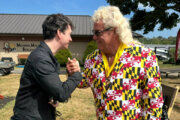WASHINGTON — As the Silver Line continues to be successful in year one with passengers, the second phase, running out to Dulles International Airport and beyond, is ramping up.
Much of the work so far has been done at Dulles International Airport and near the Dulles Greenway. The Metropolitan Washington Airports Authority oversees the project, and the decision to start there was made out of convenience. It’s easy to start work at Dulles Airport because MWAA already owns the land, thus avoiding a complicated permitting process.
“East of the airport, you will see the foundation work beginning for the Reston, Herndon and Innovation stations. Work will ramp up in this area in the spring,” says Charles Stark, Dulles corridor Metrorail project executive director.
“This is going to be a very active constructive season for our contractors excavating, moving utilities and eventually pouring concrete this autumn,” he adds.
Phase 2 extends the Silver Line from Reston to Herndon and Dulles International Airport, then ending on Va. 772 in Brambleton.
Stark told transit advocates at the Action Committee for Transit that the project is scheduled to be complete in July 2018, although new regulations on stormwater management could push the end date back.
While the project hasn’t hit any major early delays, it’s not uncommon for large-scale projects to hit snags along the way. For example, Phase 1 of the Silver Line faced a number of delays. And residents of Maryland and D.C. are very familiar with delays at the Silver Spring Transit Center and in the unveiling of the H Street-Benning Road streetcar.
Stark conceded that delays can happen, and that it’s always possible that the project could be delayed. But he says that whenever the rest of the Silver Line opens, it will bring a lot of new development to western Fairfax County and eastern Loudoun County.
“As people learn to use public transportation, it changes their lives. They don’t need as many cars in a household and it takes cars off the highway. There might not be an immediate drop-off in your traffic, but it means we can fit more commuters on our roads and rails,” Stark says.





